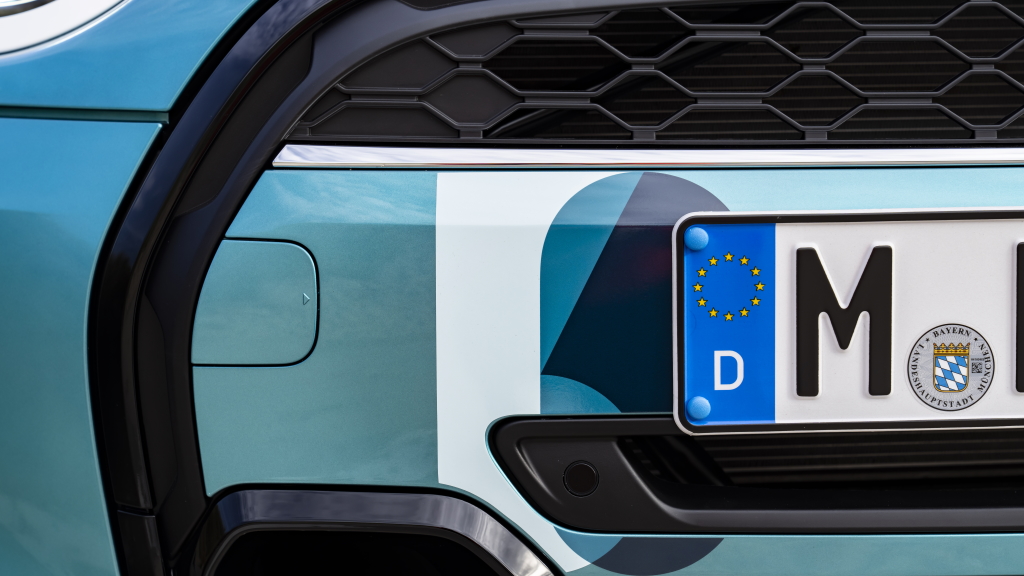Based on either the standard three-cylinder Cooper cabriolet or the quicker four-cylinder Cooper S variant, the Seaside Edition gets a whole bunch of badging that says 30 if you squint really hard, along with a choice of two colors. You can spec Nanuq White if you’re alright with something a little bit boring, or you can tick the box for Caribbean Aqua if you really want to play up the seaside part of things.
In addition to badges and paint, you get heaps of equipment like sat-nav and leather upholstery, plus a rather neat set of bodyside stripes and some loud graphics on the front bumper to really drive home that this is a special edition Mini. Mind you, I’m not sure how pleasant that black leather will be during a day in the sun, but at least it should be easy to clean.
It’s all well and good that Mini is rolling out a special cabriolet, but there’s just one tiny problem: the Mini Seaside Edition doesn’t actually mark 30 years of Mini cabriolets!
To explain why, let’s go back almost 32 years to 1991, when Rover still had control of the Mini brand. With Alec Issigonis’ iconic little car enjoying a cultural renaissance of sorts, Rover wanted to cash in through special models, and a cabriolet seemed like one way to do it. There’s just one problem: slicing the top off of a car is expensive, and Rover just wanted to dip its toe into the pool to check the temperature. Cue Lamm Autohaus.
As you can probably tell by the name, Lamm Autohaus was a German firm that had been chopping the tops off of Minis since the 1980s. Rover simply rang this specialist up, placed an order for 75 drop-top Minis, all with right-hand-drive and all in red with red roofs and special body kits. Those 75 cars were then shipped to just 12 Rover dealers in preparation for sale. At the time, the price tag was astronomical – £12,250 for a Mini. For context, a 1991 Mini Cooper initially retailed for a much more reasonable £6,595.
Despite the high price tag, all 75 cars sold within a month, making the program successful enough to justify more drop-top Minis. Instead of contracting Lamm Autohaus for more conversions, Rover turned to Karmann and Tickford for help bringing production in-house, and revealed the car in October of 1992 with sales starting in 1993. Will Mini amend the special badging on the 2023 Mini Seaside Edition to say 32 instead of 30? Absolutely not. They’re too afraid to admit the truth (or, maybe, I’m just being enormously pedantic and this doesn’t matter at all). (Photo credits: Mini, sellers)
The Makers Of The Smallest Car In The World Also Made This Amazing Mini-Based Kit Car
Our Professional Car Designer Draws A Mini Truck Made By Mini
The Mini Aceman Concept Seems Like A Fun, Square-Stanced, Electric Subcompact Crossover
Here’s What Mini Did Wrong When It Modernized The Classic Mini Look In 2001
The Designer Of The Mini Responds To My Critiques And Is A Bit Salty
Got a hot tip? Send it to us here. Or check out the stories on our homepage.
Support our mission of championing car culture by becoming an Official Autopian Member.
Oh, yes, please please please. But make all the tech an option, as I want full adaptive cruise, ventilated seats (in beige, gray, etc — not black), and all the other goodies.
Build it right, and I’ll stop buying Audi Cabrios (at least until they offer an e-tron softtop)
I’ll buy one if it’s not made in China, it’s made before 2026, and it has manual seats.
Honestly convertibles are prime for becoming BEVs. There’s a reason why almost noone made diesel convertibles (even though VW could have made diesel cabrios easily) because noone likes sucking soot down their lungs because they want to have their convertible top down.
With a BEV convertible it’s just wind noise and air that’s only getting cleaner with time (in the US at least).
I genuinely see no reason to get the Hardtop Mini BEV in the US and once the Fiat 500e gets here in 2024 I doubt anyone will buy Hardtop Mini BEVs. I believe however a proper convertible Mini BEV would sell well (for a Mini BEV) and it would be the only proper convertible BEV on the market (even Fiat’s “convertible” 500e is just a retractable soft top, it doesn’t properly go down allowing for crossdrafts and such) and in doing so it would have the market cornered.
Or, maybe not, they also retained the trademark registrations for Riley and Triumph cars, and they clearly never intended to actually use those
Have to say that the interior is pretty nice with all that wood.
Good work!
P.S. I love my R53, so much aftermarket fun for flinging it around the twisties, and the purchase of the car was cheap enough to not feel guilty when I mushroomed the shock towers through my defender plates.







